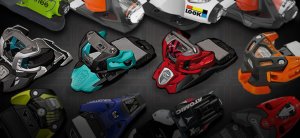We have done skis and boots in our Numbers series ... and what brings them together? The binding. The binding is probably the most misunderstood and underappreciated piece of gear that we own, yet it also the one we put the most faith in. A binding can make your day or break your leg -- or at least tear up your knee. A binding is about trust and expectations: we trust that it will work, and we expect it to perform. As to its basic function, "retention" and "release" actually mean the same thing to different people, ie, safety, because sometimes we want the ski to come off, but other times a fall would be the safer option and we want the ski to stay on. And here we are, expecting these two mechanical devices combined from metal, rubber, and plastic to figure out all that.
In Part 1, we will talk about the retention part of the numbers. The retention is what can equate to performance. A binding affects performance because it is the interface between you and the ski; as you put pressure to the boot, it needs to get to the ski. A better binding will be more laterally rigid. If you want your ski to be on a higher edge and expect, say, a 45° angle, you want that ski to be there. A lesser binding can flex laterally because of lighter materials, and you might not get that edge angle you were expecting, thus not the control of the ski that you want.
Like the tires on your car, bindings are crucial to both safety and performance and not a place I would suggest taking a shortcut. When you are looking at a better binding, you are not just buying a bigger or stronger spring, you are also buying a better housing. And, like tires, as long as the binding has a DIN range that matches your setting, it is never a bad idea to get the best option possible. As a binding moves up in price, it usually has more metal in the construction and is thus better built. You will hear a more positive “thunk,” not just a “snap,” when you click in. There will be level of substance, the feel of a machined mechanism and not just some plastic Lego pieces stuck together. Will a better binding be heavier? Usually, but where you might notice the extra hundred grams when carrying the skis, that additional weight will transfer to a better experience on the snow -- and that is what skiing is all about.
There is a reason some bindings are two to three times more expensive than others. Even though they do the same job in release, their performance makes a difference. Most skiers do not need to spend $400 for a top-of-the-line Look Pivot 18/Marker Jester Pro/Tyrolia Attack 18, but the average skier could take one step down from the top, which is actually a giant leap up from the average 12DIN binding that costs $150 to $200. So, for the cost of a lift ticket or Gatorade at your favorite resort, you get to click into a binding that will not only be safe, but also perform better.
at your favorite resort, you get to click into a binding that will not only be safe, but also perform better.
Okay, so there weren't that many numbers there, but stay tuned for Part 2!
In Part 1, we will talk about the retention part of the numbers. The retention is what can equate to performance. A binding affects performance because it is the interface between you and the ski; as you put pressure to the boot, it needs to get to the ski. A better binding will be more laterally rigid. If you want your ski to be on a higher edge and expect, say, a 45° angle, you want that ski to be there. A lesser binding can flex laterally because of lighter materials, and you might not get that edge angle you were expecting, thus not the control of the ski that you want.
Like the tires on your car, bindings are crucial to both safety and performance and not a place I would suggest taking a shortcut. When you are looking at a better binding, you are not just buying a bigger or stronger spring, you are also buying a better housing. And, like tires, as long as the binding has a DIN range that matches your setting, it is never a bad idea to get the best option possible. As a binding moves up in price, it usually has more metal in the construction and is thus better built. You will hear a more positive “thunk,” not just a “snap,” when you click in. There will be level of substance, the feel of a machined mechanism and not just some plastic Lego pieces stuck together. Will a better binding be heavier? Usually, but where you might notice the extra hundred grams when carrying the skis, that additional weight will transfer to a better experience on the snow -- and that is what skiing is all about.
There is a reason some bindings are two to three times more expensive than others. Even though they do the same job in release, their performance makes a difference. Most skiers do not need to spend $400 for a top-of-the-line Look Pivot 18/Marker Jester Pro/Tyrolia Attack 18, but the average skier could take one step down from the top, which is actually a giant leap up from the average 12DIN binding that costs $150 to $200. So, for the cost of a lift ticket or Gatorade
Okay, so there weren't that many numbers there, but stay tuned for Part 2!
